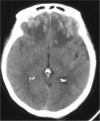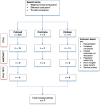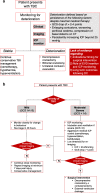Demographics, presentation, and clinical outcomes after traumatic bifrontal contusions: a systematic review
- PMID: 31098790
- PMCID: PMC7231798
- DOI: 10.1007/s10143-019-01098-0
Demographics, presentation, and clinical outcomes after traumatic bifrontal contusions: a systematic review
Abstract
Traumatic bifrontal contusions (TBC) form a recognised clinical entity among patients with traumatic brain injury (TBI). This study aims to systematically review current literature on demographics, management, and predictors of outcomes of patients with TBC. A multi-database literature search (PubMed, Cochrane, OVID Medline/Embase) was performed using PRISMA as a search strategy. Studies were selected by predefined selection criteria (PROSPERO: CRD42018055390), and risk of bias was assessed using an adapted form of ROBINS-I tool. Of the 275 studies yielded by the literature search, seven articles met the criteria for inclusion, all of which were level III evidence. Total cohort consisted of 468 patients; predominantly male (n = 5; 303/417 patients) with average age 44.3 years (range, 7-81). Falls (44.9%) and road traffic accidents (46.6%) were the commonest mechanisms of injury with an average presentation GCS of 9.2 (n = 3, 119 patients). GCS on admission of ≤ 13.1 and contusion volume at day 2 post-injury of ≥ 62.9cm3 were associated with increased risk of deterioration needing surgical interventions (n = 1, 7 patients). The majority of patients underwent surgery; the average GOS was 4, at an average follow-up duration of 11.7 months (n = 6, 356 patients). The currently available evidence on the management of TBC is scarce. Larger multicentre well-designed studies are needed to further delineate the factors behind acute deterioration, the effectiveness of management options. Once in place, this can be used to develop and test an algorithmic approach to management of TBC resulting in consistently improved outcomes.
Keywords: Bifrontal contusions; Neurosurgical outcomes; Systematic review; Traumatic brain injury.
Conflict of interest statement
The authors declare that they have no conflict of interest.
Figures



References
-
- Cooper DJ, Rosenfeld JV, Murray L, Arabi YM, Davies AR, D’Urso P, Kossmann T, Ponsford J, Seppelt I, Reilly P, Wolfe R, Investigators DT, Australian, New Zealand Intensive Care Society Clinical Trials G Decompressive craniectomy in diffuse traumatic brain injury. N Engl J Med. 2011;364:1493–1502. doi: 10.1056/NEJMoa1102077. - DOI - PubMed
-
- Dong JR, Xu QY, Cai XJ, Wang B, Wang YH, Shi ZH, Liu B, Cai S, He JQ, Hu X. Endoscopy-assisted cerebral falx incision via unilateral approach for treatment of dissymmetric bilateral frontal contusion. Chin J Traumatol = Zhonghua chuang shang za zhi. 2012;15:92–95. - PubMed
-
- Faul MXL, Wald MM, Coronado VG. Traumatic Brain Injury in the United States: Emergency Department Visits, Hospitalizations and Deaths 2002–2006. Atlanta (GA): Centers for Disease Control and Prevention, National Center for Injury Prevention and Control; 2010.
Publication types
MeSH terms
LinkOut - more resources
Full Text Sources
Medical
Miscellaneous

